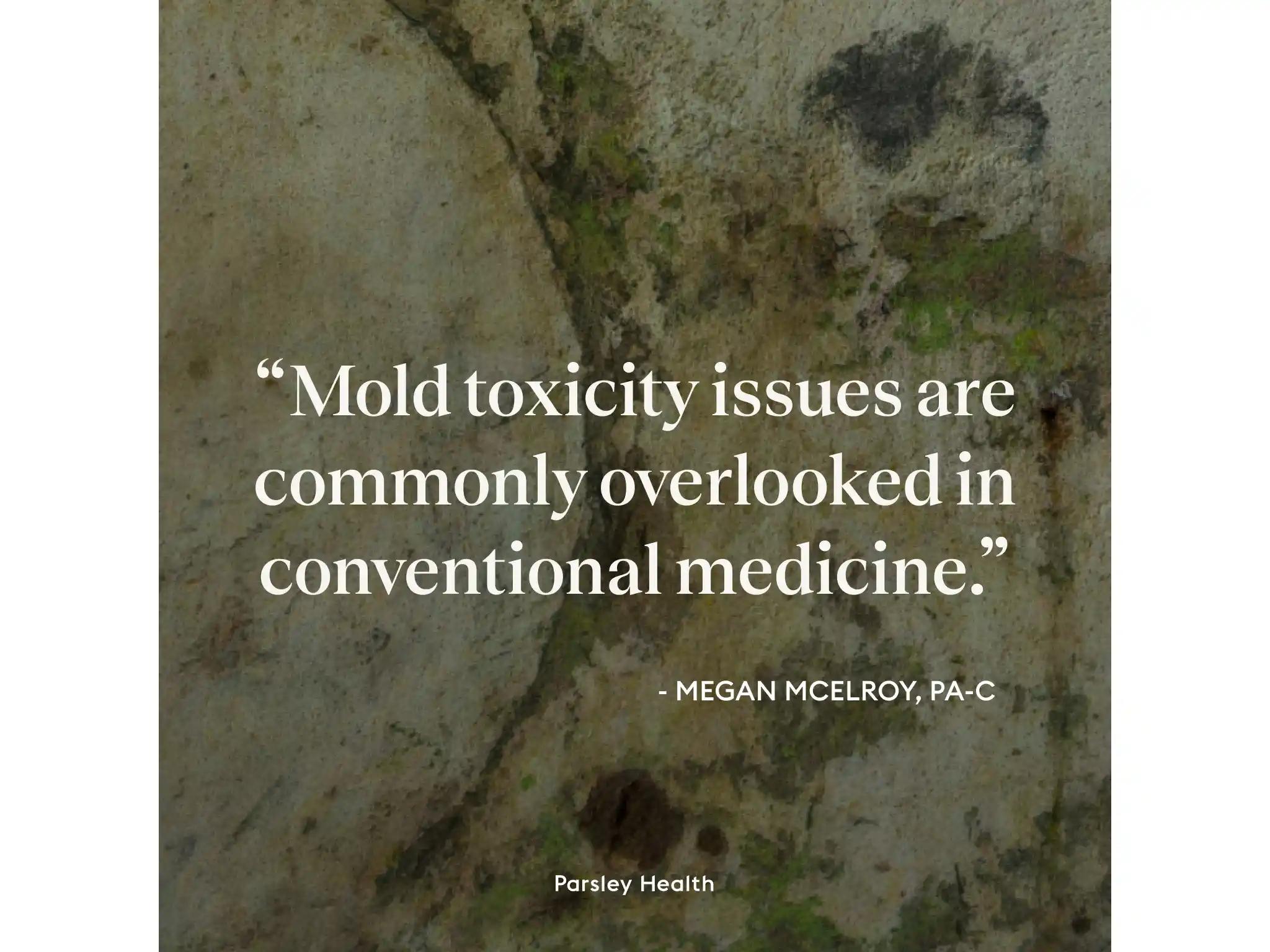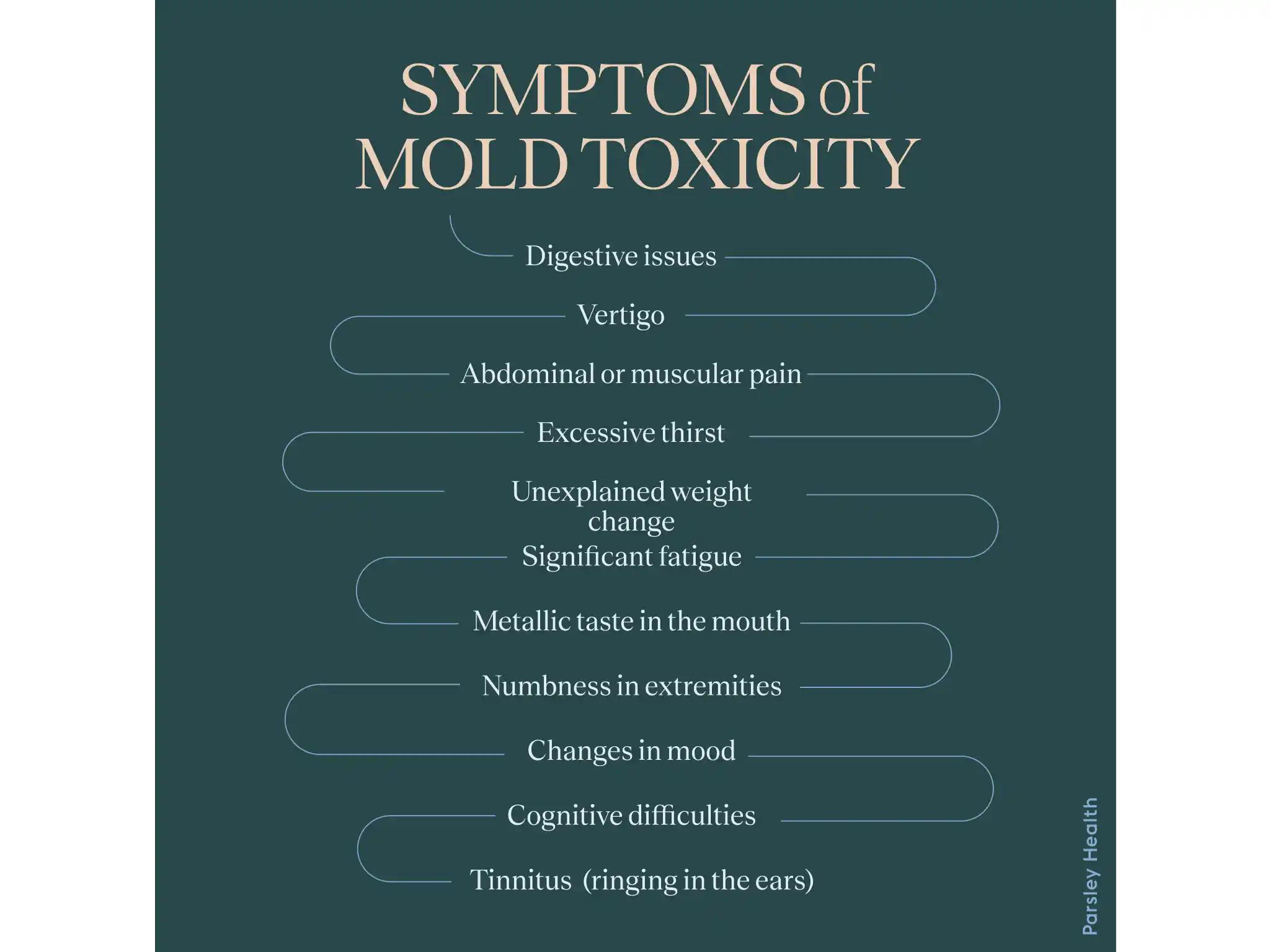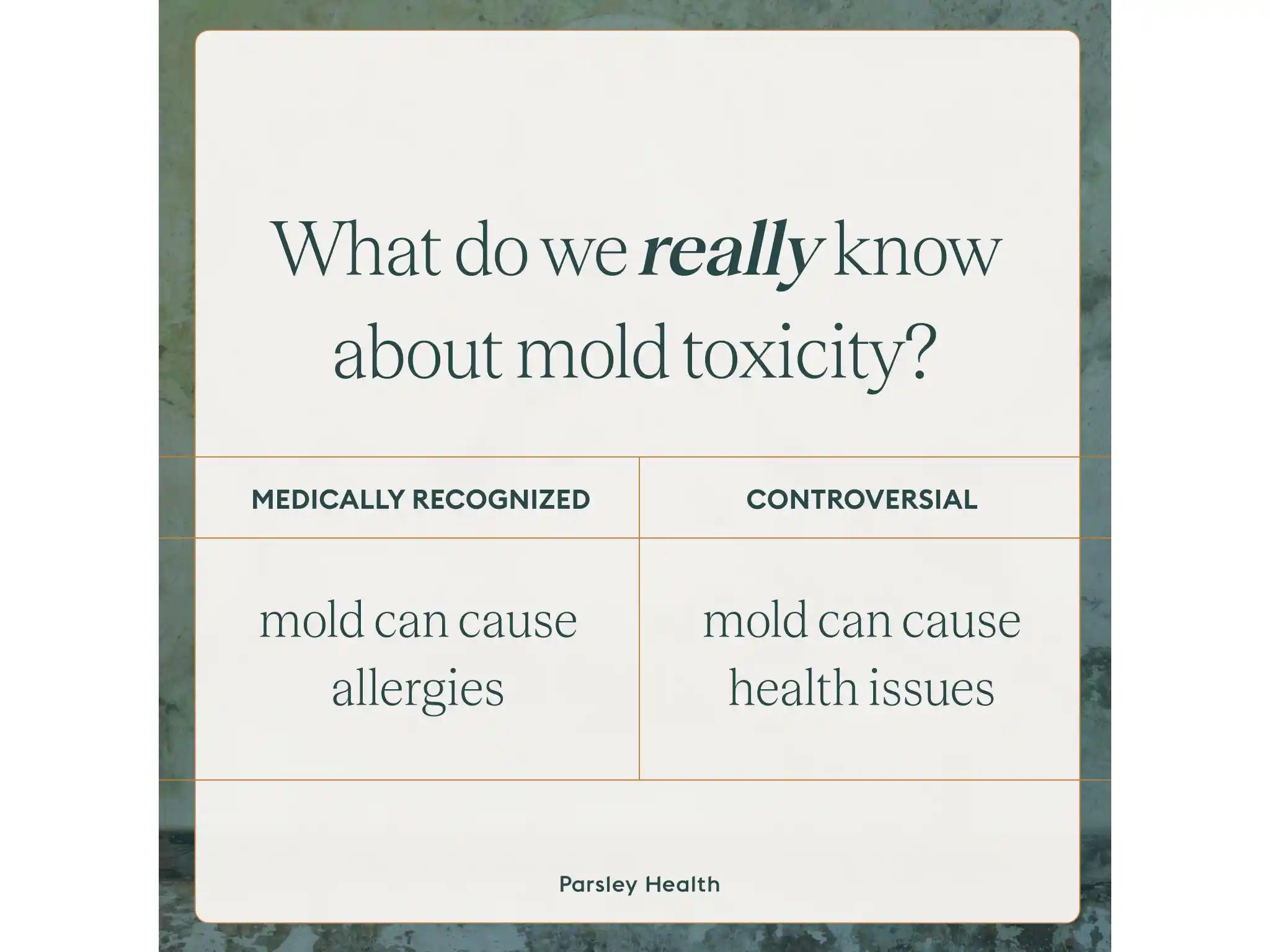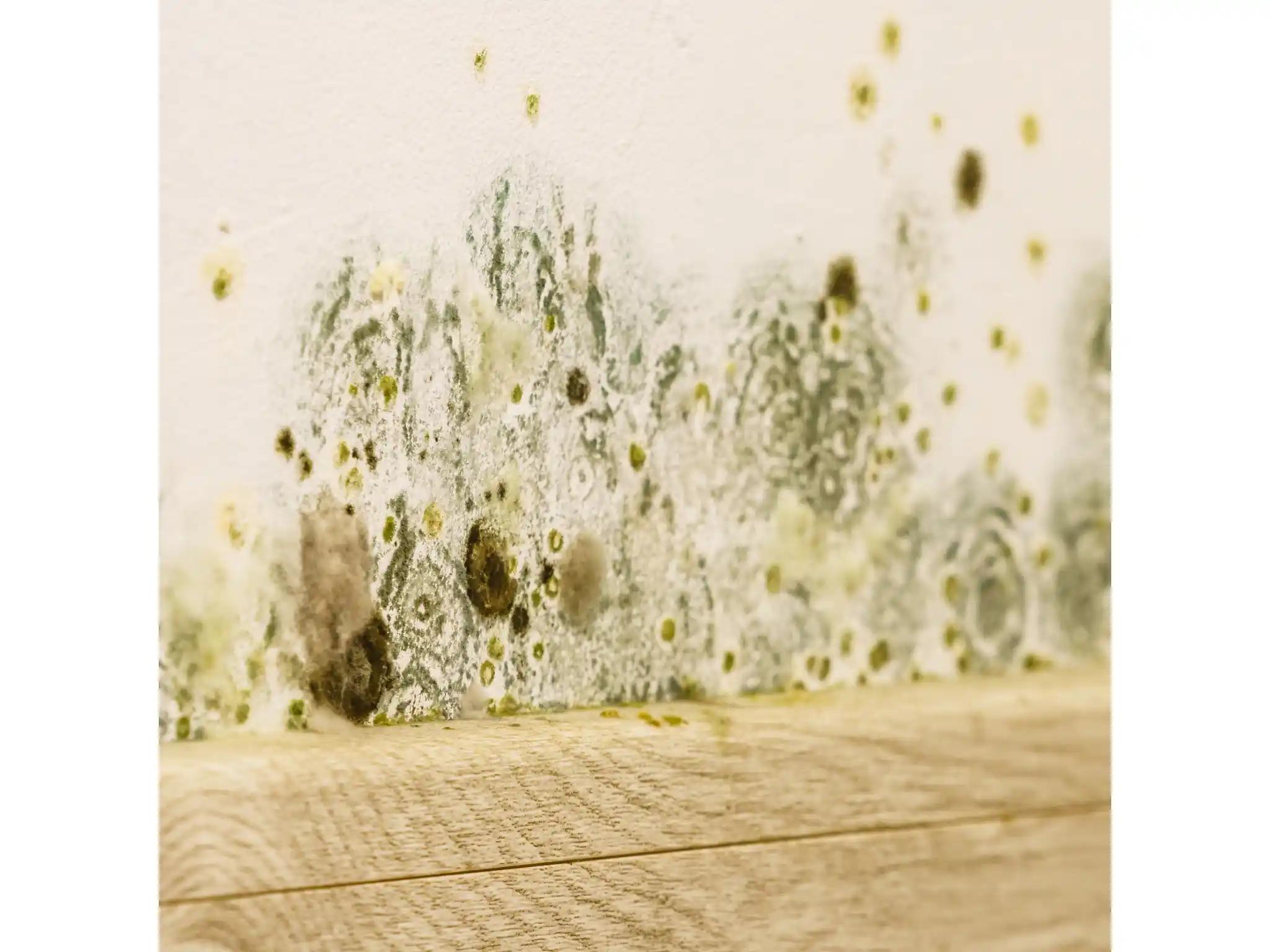This article has been medically reviewed by Nisha Chellam, MD, and contains additional reporting by Jennifer Chesak.
Symptoms from mold exposure are real and affect people every year, including homeowners, renters, and employees working in environments prone to mold exposure.
Symptoms vary—from cognitive issues, like brain fog, to allergic reactions, such as coughing and sneezing. The range of symptoms can make mold toxicity difficult to diagnose, especially since it can mimic other conditions, such as asthma.
While diagnostic mysteries about unexplained symptoms are interesting to watch on your favorite medical show, experiencing them firsthand is frustrating. The good news? Mold exposure symptoms can be combated if you know what to look for.
Yet the effects of mold are often misdiagnosed, undiagnosed, or left untreated in conventional medicine. So let’s break down mold toxicity, what that really means, and how Parsley Health takes a root-cause approach.
What is mold toxicity?
When you’re exposed to too much mold, spores that you’re sensitive to, or certain types of mold known to cause health issues, you can develop a condition called mold toxicity.
Different types of mold are around us all the time, but some are more dangerous than others. Some people have mold allergies or sensitivity to the naturally occurring toxins, called mycotoxins, that mold can emit. People with weakened immune systems from various conditions may also be more susceptible to mold toxicity.
Mold is a common fungus that grows in places with a high humidity level, like basements or bathrooms, or a lot of moisture, like roofs, pipes, wood and tile floors, and ceiling tiles. These are places where water leaks can occur, creating an environment where mold can flourish.
You can be exposed to mold at home or where you work. Structures and buildings with poor ventilation, plumbing, drainage, and more are prone to mold growth.
Mold and other fungi can also grow in soil, especially in areas with high rainfall and humidity or with lots of decaying vegetation. And mold can grow in water, including tap sources. Exposure can occur from water vapor emitted while showering, washing hands or brushing teeth, flushing toilets, and more.
Mold that grows in soil and water typically doesn't pose a threat to the general population. But for people who have weakened immune systems or sensitivities, these molds may cause symptoms.
According to Megan McElroy, PA-C, a physician assistant at Parsley Health: “Mold toxicity issues are commonly overlooked in conventional medicine.”

Mold toxicity can cause a wide range of symptoms that can be hard for you to describe. Your provider may also have a hard time piecing together why you're experiencing certain symptoms. This is especially true if they don’t have experience and training in mold issues. However, your symptoms may not be related to mold but caused by something else entirely.
What are the symptoms of mold exposure?
The symptoms of mold issues can be divided into two main categories. The first category, McElroy says, is an immune system reaction to mold spores, which typically involves allergy symptoms or allergic rhinitis. These may include a runny or stuffy nose, a skin rash, itchy skin and eyes, asthma symptoms like shortness of breath, and more.
The second type of mold issue is a chemical and inflammatory reaction to mold. As McElroy explains, this is driven by mycotoxins, which can initiate an inflammatory response in the body.
A small Harvard study in the journal PLOS One reports that people who have experienced exposure to toxic mold spores have different cytokine profiles than those without exposure. Cytokines are immune system proteins that can either combat inflammation or cause it.
Some people, especially those who are immunocompromised or have chronic lung disease, can develop a mold infection in their airways, according to the CDC. These infections, called mycoses, can activate mast cells, which are part of the immune system. This activation can cause symptoms such as coughing, wheezing, sinusitis, and even cognitive difficulties.
Inflammation caused by mold exposure can create symptoms that are vague, broad, and very hard to pin down.
12 symptoms that may be related to mold exposure
Cognitive difficulties (brain fog, poor memory, anxiety)
Pain (especially abdominal pain, but can include muscle pain similar to fibromyalgia)
Unexplained weight gain or weight loss
Numbness and tingling in extremities or other areas of the body
Metallic taste in the mouth
Vertigo or dizziness
Tinnitus (ringing in the ears)
Digestive issues (especially limited tolerance to food, persistent bloating)
Significant fatigue that interferes with daily activities
Changes in mood
Excessive thirst and dehydration, bed-wetting in children
Symptoms that resemble hormone imbalances (hair loss, rashes)

As McElroy explains, “the symptoms of mycotoxin-induced illness vary and have no pattern, and they are not unique to this illness,” which means they can easily be mistaken for something else. Or they may even be something else.
Why are mold issues difficult to diagnose?
The topic of mold toxicity or injury is controversial. Scientific research and journal articles both acknowledge the issue and say it's a myth. Other articles point to "media hype" about the hazards of mold.
Some preliminary research does show that mold can present health issues. And the Environmental Protection Agency acknowledges that mold exposure can cause symptoms in both allergic and non-allergic people.
Doctors largely recognize that mold can trigger allergies and asthma and that mold can sometimes cause lung infections. They also recognize that overexposure to mold in the workplace and at home may be linked to hypersensitivity pneumonitis (HP). HP can occur when people inhale problematic dust, which can be contaminated with mold.
Ultimately more research is needed to uncover the best strategies for determining if someone's symptoms are related to mold exposure, and if so, what to do about it.
“Conventional medicine recognizes that mold can cause allergies but does not recognize that mycotoxins emitted by some species of indoor mold can cause a problem,” says McElroy.
Doctors unfamiliar with mold and mold treatment may miss one of the main types of mold reactions—the chemical and inflammatory reaction. This is for a few reasons.
The concept of mold toxicity remains controversial
Mold testing does not have a gold standard
Mold injury does not have a standardized treatment protocol
Few human-based studies have looked at the connection between a moldy environment and human health
Studies that do exist sometimes contradict one another
The presentation of mold issues is very different among patients
Not everyone exposed to mycotoxins will have a reaction to them
Airway infections from mold often mimic asthma and COPD symptoms
Fortunately, root-cause medicine providers consider environmental factors that affect health when evaluating patients and may have additional advanced training in treating mold exposure symptoms.
One of the biggest challenges with mold is that mycotoxins can cause only some people to launch an inflammatory response. “This unpredictable response can go on for years after a long-term exposure in a susceptible individual,” McElroy explains.
Ultimately, if you're experiencing unexplained symptoms that are affecting your quality of life, persuing the root-cause is important. The symptoms may not be due to mold at all, but something else.

How do you test for toxic mold exposure?
“All in all, there is no simple way to diagnose mycotoxin illness,” says McElroy. But testing is typically the first step. She prefers to start patients with at-home tests and also recommends a home inspection by a certified mold inspector. “[At-home tests] should only be ordered, in my opinion, once the environment is evaluated for the source of mold,” McElroy explains.
The most direct test for mold exposure is a urinalysis. You pee into a cup, and your provider measures your urine for metabolites of mold and mycotoxins as well as glutathione levels. Glutathione is an antioxidant the body makes. Levels can be depleted when you’re exposed to mold.
For patients suspected of having a mold infection in their airways, a sputum culture, which analyzes your phlegm, may help make a diagnosis. Other tests may also be required.
”I never place the entire diagnosis of mycotoxin illness on tests alone,” McElroy says. Why? Because mold tests have some major drawbacks.
False negatives and false positives are common
Many are not covered by insurance
You can’t test all toxins—there are hundreds
The levels found on tests don’t necessarily correlate with the severity of symptoms
These tests clearly aren’t perfect. McElroy says she has seen patients with intense symptoms have almost nothing show up on the test while the healthy spouses of those same patients register values off the charts. Having a medical provider who's willing and able to do some extra investigation into symptoms of mold exposure is key.
What is black mold and is it dangerous?
"Black mold" isn't one specific type of mold. Instead it's a term used to describe the color of several different species, usually those that are green or black. A common type of black mold is Stachbotrys chartarum.
A fungus's color doesn't dictate how it affects your health, according to the CDC. However, a 2023 study in the journal Behavioral Brain Research, showed that mice that inhaled Stachbotrys chartarum spores experienced cognitive issues. The symptoms were also linked to brain inflammation.

Stachbotrys chartarum is considered a toxigenic mold, one that may cause inflammation when people are regularly exposed. However, more research is needed since existing studies are inconclusive.
How do you treat mold toxicity symptoms?
Treating mold toxicity often involves a mix of methods.
“Right now, you’ll see a lot of experts recommending handfuls of supplements and strict diets but the reality is, we just don’t know for sure if these are the right treatment approach,” says McElroy.
“Killing the mold," or mold remediation, offers a first step, but supporting the immune system usually gets more attention. As McElroy explains, “I often don’t focus on ‘killing’ mold since most symptoms are due to the immune response, not the mold itself.” Instead, she starts with simple lifestyle steps and utilizes non-pill practices to achieve a state of better immune health, including the following.
Eliminate exposure
Eliminate the sources of the mold from the environment if you can. But also eliminate common dietary sources of mold, including grains, coffee, and peanut butter. This will help reduce the overall mold burden on the body.
Address sinus health
“Since molds can colonize the sinuses, I like to collaborate with ear-nose-throat doctors on this,” says McElroy. That said, you can also take steps to improve sinus health at home, including healing the gut since 70 to 80 percent of our immune system is located there. (Here’s how to achieve better gut health.)
Address lung health
If you have asthma or COPD, you know how important it is to maintain lung health with your regular regimen. But sometimes exacerbations with these conditions occur, and they could be brought on by mold exposure or an infection. Your Parsley Health provider may also collaborate with a pulmonologist or immunologist to ensure you're getting the right care for your conditions.
Start a neural retraining program
Our autonomic nervous system has two main branches, the sympathetic nervous system, also called the "fight-or-flight " response, and the parasympathetic nervous system, or the "rest-and-digest" response.
When you're not feeling well or experiencing airway inflammation, the nervous system can engage in a chronic fight-or-flight response.
“No pill can fully stop this response, so we have to ‘retrain’ certain neural pathways to put the response into a ‘heal-and-rest’ state.” She often recommends Annie Hopper’s Dynamic Neural Retraining System. “This is essential for full recovery,” says McElroy.
Lower inflammation
Taking steps to lower inflammation can help return balance to a compromised immune system. This means following an anti-inflammatory diet and committing to daily stress-management habits. Parsley Health providers often work with members to develop personalized strategies to reduce inflammation, which may include:
Eliminating added sugar
Eliminating ultra-processed foods
Eliminating intake of processed carbohydrates
Reducing intake of omega-6 fatty acids
Boosting intake of omega-3 fatty acids
Boosting intake of fiber
Optimize liver health
Supporting the body’s natural ability to get rid of toxins is a key part of healing from mycotoxin exposure. Supplements can be helpful. Some of McElroy's go-to options include antioxidants like glutathione and N-acetylcysteine (NAC), charcoal, and bitter greens, which all support the liver. It’s important to work with a practitioner experienced in mold illness, like those at Parsley Health, who can recommend the right supplements and doses of each.
Address pre-existing conditions
If you have pre-existing conditions and a history of mold exposure, ensure that your conditions are adequately cared for. Mold exposure may exacerabate the following.
Allergies
Amyotrophic lateral sclerosis (ALS)
Asthma
Inflammatory bowel disease (e.g., Crohn's and colitis)
Multiple sclerosis (MS)
Parkinson's disease
How to prevent mold exposure
Preventing mold exposure can be tricky. But a few steps can help, according to the CDC.
Assess your home for any leaks and repair them
If you rent, talk to your landlord about any mold concerns
Run ventilation fans when showering, bathing, or cooking
Ensure that your dryer vent is in good condition and ventilates outside
If your home is especially humid, run a dehumidifier
Clean your home regularly and look for mold growth
Wear a mask when cleaning
Add mold inhibitors if you paint your home or rental
Remove any musty carpets or rugs
Clean up your home immediately after a flood
If you suspect mold exposure in your workplace, talk to your HR department
What if it isn't mold?
Your unexplained symptoms may not be related to mold exposure at all. Other considerations include the following, which could be undiagnosed at the moment.
Allergies
Asthma
Autoimmune disease (e.g., mast cell disorders)
COPD
Respiratory infection
Sinus infection
Tick-borne illness (e.g., Lyme disease)
If you're having unexplained symptoms that don't resolve, be sure to talk to your doctor to get to the root cause.
FAQ
What are the common types of mold?
Potentially more than 1 million types of mold exist. Molds generally fall into three main classifications: allergenic, toxigenic, and pathogenic. Some molds may fall into more than one category.
Allergenic molds may cause an allergic reaction in people with mold allergies. More than 150 allergenic molds could cause symptoms. Common allergenic molds include Alternaria, Helminthosporium, and Aspergillus.
Toxigenic molds can cause inflammation that may lead to mold toxicity symptoms. A common toxigenic mold is Stachybotrys chartarum, commonly called black mold.
Pathogenic molds can cause infection. Common pathogenic molds include those in the Aspergillus species.
Is black mold harmful?
The color of a mold doesn't dictate its danger level. All types of mold, including black mold, can cause reactions in those who have a mold allergy or sensitivity. Black mold, known as Stachybotrys chartarum thrives on warm damp wood and drywall.
How long does it take to get sick from mold exposure?
If you have a mold allergy, you might react as soon as you encounter mold spores. If you do not have an allergy but are sensitive to mold, symptoms may take time to appear.
Can you heal from mold toxicity?
The short answer is yes. The first step to healing will be to avoid exposure. This may involve taking mold remediation steps, changing diet, and more. The second step will be to incorporate health and lifestyle changes. These may include addressing allergies, taking supplements or changing diet to help reduce inflammation, and more.
Takeaway
“Mold toxicity is difficult to diagnose, as many patients are pushed aside by practitioners and loved ones, and it involves more than pills for treatment,” McElroy explains.
Resolving mold exposure symptoms can be a financially, emotionally, and physically stressful experience and there is no cut-and-dried diagnosis and treatment. “It takes patience, persistence, and recognition that more treatments are not usually the answer,” she continues.
The reality is that we are still in the infancy stage of understanding toxic mold exposure symptoms, and we need more research to get a better picture of how to address these health issues. However, knowledgeable medical providers are within reach and ready to develop a customized science-backed plan to get you feeling your best.
Ready to take control of your heart health? Schedule a free call to learn more about Parsley’s root-cause approach, using insurance with Parsley, and how we can personalize your health journey.

